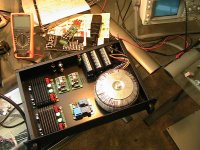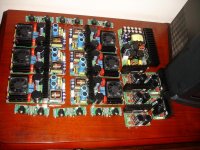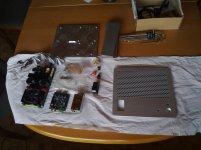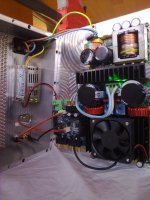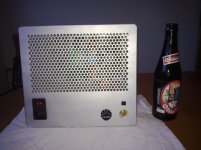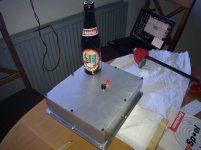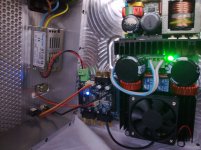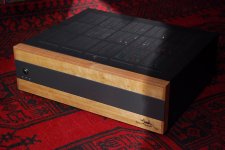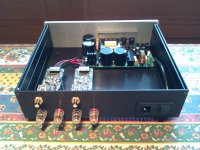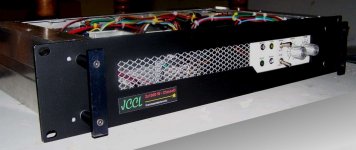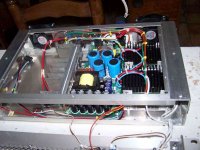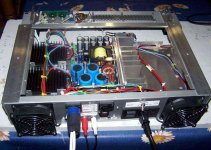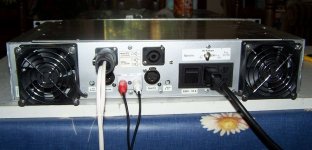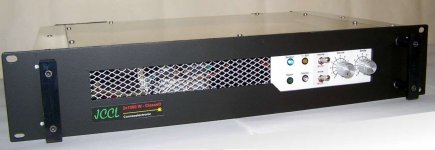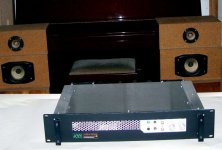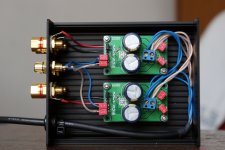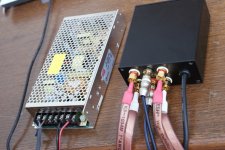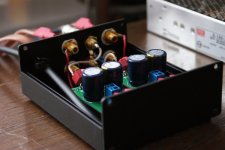Mini pcm2704 dac
This is great. Congratulations.
I would like to ask you: Is this mini DAC a good one? How did you connect it? How did you ground the whole system?
Sorry for too many questions, but I'm working in someting similar. (Even the tissue box, only made by me).
RGDS
Pemo
This is great. Congratulations.
I would like to ask you: Is this mini DAC a good one? How did you connect it? How did you ground the whole system?
Sorry for too many questions, but I'm working in someting similar. (Even the tissue box, only made by me).
RGDS
Pemo
Connexelectronic Review
Hi Everyone,
It's been so long since I have had time to come on here in the Tripath arena and look around.
I have noticed some questions re Connexelectronic and noticed some people are on the fence and others are making decisions based on pictures and third part hearsay.
As for some history I am a professional audio engineer, I have been known to design, build, repair, record, produce and pretty much live in recording studios from back when we had giant machines with two inch magnetic tape and tubes. Don't laugh as many of you may know some of the best sounds came from these analog chains!
A couple years ago I was designing a mobile unit and needed some high power that was efficient. When performing field tracking sessions one would need not be concerned about the various venues having enough amperage to drive a rack of class A or Class A/B amplification, along with computers, tube mic's, class A preamp channels 192 A/Ds etc... After hearing one of those cheap low powered plastic Tripath 2020's if memory serves, we were blown away.
Up until then I had personally relegated class D to either only low low frequencies or as ear killers for some kids pimped out ride.
Around this time Tripath had been dissolved and there was nothing high power class T available off the shelf to shove in a rack. There were a few companies making kits from what basically looked like clones of the original Tripath evaluation boards. While one of these kit companies actually seemed to have an idea of what they were doing, by that I mean using proper thickness cladding, grounding etc. this level of care only seemed relegated to their top priced offerings.
Via reading through tons of posts I came upon Connexelectronic as they are a very quiet company for some reason. For less that the price of a kit where we would spend many more hours/days soldering a bunch of tiny surface mount components... I still like through hole as among other things my eyes are not what they used to be... we ordered our first boards from Connex. Truthfully I was a bit skeptical due to the prices and country of origin. Upon arrival I was pleasantly surprised by the level of care that went into the fabrication of these units, high quality components throughout, extremely pristine soldering and even easily decipherable schematics. What ended up seemingly another audio chore turned into a pleasant undertaking as I was able to use my own quality cabling and interconnects rather than what would have been provided in a retail fully assembled unit. In my opinion these parts do make a difference...
Since then we have trusted Connexelectronic to supply over ten thousand watts worth of Tripath boards and supplies, yes we are RMS freaks, and we have developed a wonderful rapport with the owner. Cristi has always been excellent in responding to the sometimes quirky nature of our requests, our high expectations of design and of course our ultimate requirement for expeditious response regarding technical issues.
The few issues we have encountered were due to operator error rather than design or build flaws. These amps are very fast and powerful and can reproduce dynamics in live situations that require one take hf driver protection to heart. Also being a chip amp they are not as robust as discrete components and one should always take relevant precautions such as shutting off power prior to connecting/ disconnecting these into/out of the signal chain. In other words simply never make changes while powered up with signal on the inputs or outputs and it's all good.
The picture of our first 3020 Tripath thousand watt amp going through layout iterations and our other picture of the latest 3020 revisions prior to being loaded into chassis.
Hi Everyone,
It's been so long since I have had time to come on here in the Tripath arena and look around.
I have noticed some questions re Connexelectronic and noticed some people are on the fence and others are making decisions based on pictures and third part hearsay.
As for some history I am a professional audio engineer, I have been known to design, build, repair, record, produce and pretty much live in recording studios from back when we had giant machines with two inch magnetic tape and tubes. Don't laugh as many of you may know some of the best sounds came from these analog chains!
A couple years ago I was designing a mobile unit and needed some high power that was efficient. When performing field tracking sessions one would need not be concerned about the various venues having enough amperage to drive a rack of class A or Class A/B amplification, along with computers, tube mic's, class A preamp channels 192 A/Ds etc... After hearing one of those cheap low powered plastic Tripath 2020's if memory serves, we were blown away.
Up until then I had personally relegated class D to either only low low frequencies or as ear killers for some kids pimped out ride.
Around this time Tripath had been dissolved and there was nothing high power class T available off the shelf to shove in a rack. There were a few companies making kits from what basically looked like clones of the original Tripath evaluation boards. While one of these kit companies actually seemed to have an idea of what they were doing, by that I mean using proper thickness cladding, grounding etc. this level of care only seemed relegated to their top priced offerings.
Via reading through tons of posts I came upon Connexelectronic as they are a very quiet company for some reason. For less that the price of a kit where we would spend many more hours/days soldering a bunch of tiny surface mount components... I still like through hole as among other things my eyes are not what they used to be... we ordered our first boards from Connex. Truthfully I was a bit skeptical due to the prices and country of origin. Upon arrival I was pleasantly surprised by the level of care that went into the fabrication of these units, high quality components throughout, extremely pristine soldering and even easily decipherable schematics. What ended up seemingly another audio chore turned into a pleasant undertaking as I was able to use my own quality cabling and interconnects rather than what would have been provided in a retail fully assembled unit. In my opinion these parts do make a difference...
Since then we have trusted Connexelectronic to supply over ten thousand watts worth of Tripath boards and supplies, yes we are RMS freaks, and we have developed a wonderful rapport with the owner. Cristi has always been excellent in responding to the sometimes quirky nature of our requests, our high expectations of design and of course our ultimate requirement for expeditious response regarding technical issues.
The few issues we have encountered were due to operator error rather than design or build flaws. These amps are very fast and powerful and can reproduce dynamics in live situations that require one take hf driver protection to heart. Also being a chip amp they are not as robust as discrete components and one should always take relevant precautions such as shutting off power prior to connecting/ disconnecting these into/out of the signal chain. In other words simply never make changes while powered up with signal on the inputs or outputs and it's all good.
The picture of our first 3020 Tripath thousand watt amp going through layout iterations and our other picture of the latest 3020 revisions prior to being loaded into chassis.
Attachments
Attachments
Last edited:
Texas?, live in Arizona, t-amp
Just getting the Helder's TA2020 amp connected with 2 way RCA input switch and volume control. Sounds very clear to my ear. Should the input wire be crossed, overlapped? Being new at this some advise to improve my next project will be good.





my youtube video here: http://www.youtube.com/watch?v=_Cto51GM14E
Just getting the Helder's TA2020 amp connected with 2 way RCA input switch and volume control. Sounds very clear to my ear. Should the input wire be crossed, overlapped? Being new at this some advise to improve my next project will be good.





my youtube video here: http://www.youtube.com/watch?v=_Cto51GM14E
Last edited:
Very nice project! Have you machined all those solid parts yourself? How heavy is it?Inside: 1 x TA3020 Audio Amplifier v4 from Connexelectronic 2x400w
NewclassD NCDX-discrete with SMPS
NCDX-discrete with Connextelectronic SMPS (A1000 model)
Have reduced the wiring at the minimum possible
NCDX-discrete with Connextelectronic SMPS (A1000 model)
Have reduced the wiring at the minimum possible
Attachments
Last edited:
was lucky to find 2 used Luka so have had a good price!
Yes, definitively better than other implementation with my speakers (B&W matrix 801 sII)
don't know if was the sofisticate crossovers or what but i've done a project with icepower modules (both ASX125 and 250) and there was a rolloff in the highs.
I've check an amp with Tripath TA0104 and the sound was "in your face" but less "silky" than icepower and newclassd.
That NCDX-d have a silky sound but more open and airy than my icepower pjs.
Yes, definitively better than other implementation with my speakers (B&W matrix 801 sII)
don't know if was the sofisticate crossovers or what but i've done a project with icepower modules (both ASX125 and 250) and there was a rolloff in the highs.
I've check an amp with Tripath TA0104 and the sound was "in your face" but less "silky" than icepower and newclassd.
That NCDX-d have a silky sound but more open and airy than my icepower pjs.
This is my first class D amplifier. I chose to make it with following Connexelectronic modules:
4 x IRS2092 Modular Amplifiers – 600W 4Ω. each and around 900W 8Ω in BTL mode (only 2 are mounting for a first test).
1 x Balanced Input Phase Shifter – to select symmetric / asymmetric and stereo / BTL modes
1 x SMPS2000R power supply. ± 80V 2000W and floating ± 12V.
The result is a very stable and nice sounding amplifier in stereo mode as well as in "bridged" (BTL) mode. It sounds GREAT, with powerful and strong bass, while keeping details of medium and high frequencies and without any white noise, hiss or 50Hz noise.
When I compare with a Class AB power amp, I cannot say which is better than the other.
I regret having received the modules without any documentation and specifications. Fortunately, the silkscreen printing on PCB allow do without.
Very well designed modules, with excellent construction quality and good value for money. Highly recommended!
4 x IRS2092 Modular Amplifiers – 600W 4Ω. each and around 900W 8Ω in BTL mode (only 2 are mounting for a first test).
1 x Balanced Input Phase Shifter – to select symmetric / asymmetric and stereo / BTL modes
1 x SMPS2000R power supply. ± 80V 2000W and floating ± 12V.
The result is a very stable and nice sounding amplifier in stereo mode as well as in "bridged" (BTL) mode. It sounds GREAT, with powerful and strong bass, while keeping details of medium and high frequencies and without any white noise, hiss or 50Hz noise.
When I compare with a Class AB power amp, I cannot say which is better than the other.
I regret having received the modules without any documentation and specifications. Fortunately, the silkscreen printing on PCB allow do without.
Very well designed modules, with excellent construction quality and good value for money. Highly recommended!
Attachments
Hello,
here is my newest projekt...
Helder TK2050 (two mono-amps) and a PGA2311 pre-amp.
Sounds really great without noise or humming!
Very fine details, wide stage and a spectacular dynamic and bass.
I did some changes on the TK2050 boards...
Don't like the quality of soldering and board layout from Helder.
The mass bridges were to week and desoldering nearly unpossible without destroying the board.
I did some increases at the mass bridges and changed the caps to Nichicon FG 4.700uF 35V.
The PGA2311 is also different to the pre-amps in ebay... it uses the DIP-version
of the chip with many different caps and capacities than the commercial ones (Nichicon Muse, ELNA Cerafine).
The powerboards uses 4x 15.000uF 50V ELNA caps with bypasses... toroid transformers are 24V 200VA and 6V 30VA.
But take a look for yourself... 😉




Regards
Oliver
Stunning. Officially jealous. Looking to get the Helder mono boards but will never hope to get near this..
Heh, the closest I'll get to that would be to put my amp on top of my Canon printer (have the same unit - nice machine 😀).
This is my latest project based on TPA3106D1. I have to say that it sounds great. I the near future I will post sound comparison with moded Sure TK2050.
Regards,
Ales
That is a stunningly simple looking board. What do they output?
- Home
- Amplifiers
- Class D
- Class D Amp Photo Gallery
